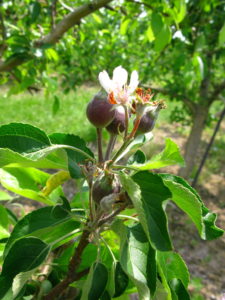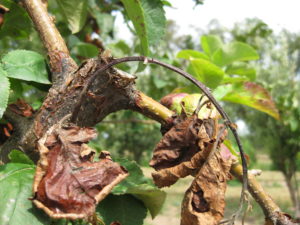In case you blinked, we went from green tip to bloom in about three days, and by the time you read this, we will have passed through the blossom blight period. For most of the state, the late spring consisted of cool, dry weather that was not conducive to blight infection in the northern half of the state. The southern half of the state was only slightly more conducive for infection. This means that any strikes seen in the next few weeks probably came from damage from last year. Since last year was unusually wet, with a lot of susceptible rat-tail blooms, it is most likely that any fire blight infections observed as shoot and canker blight can trace their beginnings to rat-tail blooms of last year (Fig. 1).
What to do now?
Until a terminal bud has formed and growth has ceased, I do not recommend pruning out strikes because pruning is not often successful in eradicating the bacteria from most infected trees. This is supported by work done by Paul Steiner, who stated “Since pruning was not successful in an experimental situation, it is unlikely that pruning would be more successful in commercial situations.” In fact, I regularly observe the continued spread of fire blight due to insufficient pruning, reinfection of new, succulent growth that suckered after pruning, or worst yet, spread of the disease by pruning tools. Similar work done by Shtienberg, D. et al., in 2003 (“New considerations for pruning in management of fire blight in pears.” Plant Dis. 87:1083-1088) found the same thing. Simply stated: Pruning did not result in successful eradication of the pathogen (Fig. 2). Period. Sometimes, the best thing to do is to wait. It was found that pruning worked best the later in the season it was performed, and the best results were obtained when pruning was carried out while the trees were dormant. None of these dormant-pruned trees in either study had a severely infected canopy the following spring.
Obviously, postponing the cutting of fire blight–infected tissues to winter may create two problems:
- the bacteria may continue to progress in the infected tissues and result in greater damage;
- delayed cutting allows infected tissues to serve as an active source of inoculum that could endanger the entire orchard.

